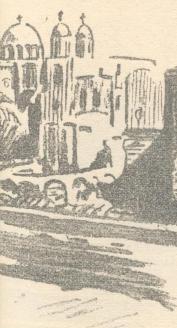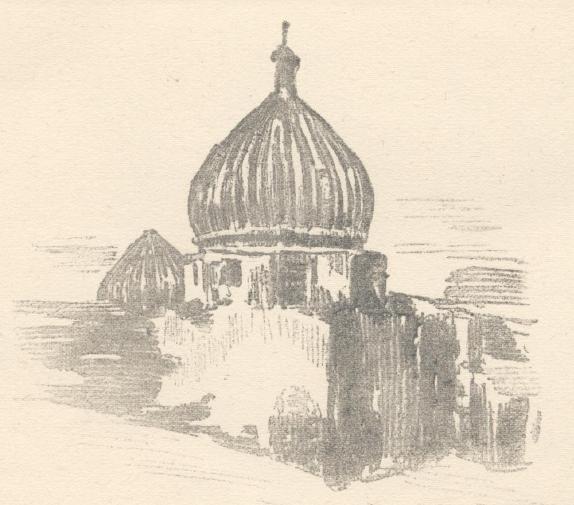
It is as difficult to condense in one short chapter the sequence of architectural history in Egypt as it is impossible to over-estimate the interest that it offers to artists and historians. For there is not one period in History that is not richly represented here by characteristic and wonderful monuments. --In order to refrain from becoming absorbed by one or other of those periods, we will arrange the monuments under six chronological headings: The Pharaonic Times.
Each of these six periods has produced enough to deserve a volume to itself.
It would seem that wood was used extensively in early buildings. At Saqqara, near Cairo, where impressive stone ruins have been found, going as far back as the IIIrd Dynasty (c. 2900 B.C.) some very remarkable imitations of wooden architectural details are to be seen in stone. The ancient Egyptians accomplished marvellous feats in the handling
of stupendous materials, but the developments brought about by the use
of the arch and the vault remained unknown to them. It is true that some
very small examples of brick vaulting have been found, also dating back
as far as the IIIrd Dynasty, but it does not seem to have occurred to the
builders to make use of that principle in order to enable them to place
their columns further apart; most hypo style halls of Ancient Egyptian
temples suffer from the crowded aspect which results from columns standing
too close to each other.
M. Capart has appropriately divided the architecture of the Ancient Egyptians into three sections: Dwellings for the gods (temples), for the dead, and for the living. Of the last, probably built of perishable materials, such as mud bricks or wood, nothing could have been expected to remain. The second included, not only tombs dug very deeply, such as are to be found at Thebes (Biban el Muluk), divided into ritual chambers which entitle them to be called architecture, but also those unique and awe-inspiring Egyptian structures called Pyramids. The best known and most important are at Giza, near Cairo, erected by Pharaohs of the IVth Dynasty, about 2500 years before Christ, but there is an even older one at Saqqara, a few miles away, the Step Pyramid, built by Zoser, of the IlIrd Dynasty, and some scarcely more recent at Abusir, Meidlim, Dahshlir, etc. etc. The third division, consisting of temples, includes buildings that date back to very early times, the oldest being the temples of Ptah at Memphis. (1st Dynasty, about 3000 B.C.). It is impossible within the limits of this too comprehensive chapter, even to enumerate the marvellous ruins of temples left to the admiration of posterity; we will merely mention the celebrated edifices of Karnak, Deir el Bahari, of an almost Grecian beauty, Abydos. Medinet Habli, Ramesseum etc. etc. GRAECO -ROMAN AND COPTIC PERIOD. Some of the most architecturally beautiful temple of Ancient Egypt belong to the Graeco-Roman period, which spreads from the conquest of Egypt by Alexander (300 B.C.), to the Islamic conquest in 641 A.D. Egyptologists often speak disdainfully of the Ptolemaic remains but it is only in sculpture, painting and engraving, and in ornament generally, that a slight decadence can be observed. Architecturally, the temples of Kom-Ombo, Philae, Edfu, Dendera, etc. present more harmony than the earlier edifices. Though the already mentioned lack of arches and vaults deprived them of the enchanting atmosphere of space which characterises medieval Egyptian domes, this is compensated by a sense of mystery due to the very crowding of the columns, suggesting a thick forest of huge trees. Again, for lack of an arch, their gates are composed of an inevitably narrow rectangular door, framed in a pylon with "battered" on slanting sides. They are, however, surmounted by aattractive, hollow cornice, which has deservedly been copied in later monuments. Under the Roman domination, beginning half a century before the Christian era, a few monuments were erected in Roman style, of which the Roman fortress of Babylon, in Old Cairo, is the most complete. --Christianity, brought very early to Egypt and practised by descendants of Ancient Egyptians now known as "Copts", inspired the building of convents in the desert, (Bawit, Wady Natnln, Sohag, etc.) ; those usually assumed the form of rectangular fortresses with massive brick walls, probably on account of ever possible attacks by nomadic tribes. In most of those, Roman influence can be traced, apses and gates being surmounted by a rounded arch.  Of the numerous Coptic churches that are enclosed in the ruins of the Roman fortress at Old Cairo, nearly all were presumably rebuilt after the destructions that took place in the Xth, and XlIth centuries, and are therefore examples of later work. It would seem, however, that the crypt of Abu Serga, the legendary resting-place of the Holy Family, and the small church in the interior of the great Roman tower, on which the modern Greek church of St. George stands, are both indisputable monuments of the earliest Christian architecture in Egypt -or. indeed anywhere. The great column in Alexandria, erroneously called Pompey's pillar, is a memento of the Roman period, and was erected, not by Pompey, but by Diocletian, in the IIIrd century, A.D.  When the Abbassides gave such powerful encouragement to Art in Islam, the Mosque was rebuilt and there are still, on the West side, interesting traces of early Moslem architecture. But it is from the IXth century onwards that we possess real architectural monuments. The first in date is in the Nilometer, dated 861, a pointed, almost Gothic arch, three centuries before the first Gothic church. Similar arches are to be found in the Aqueduct built by Ibn Tulftn,
Deputy Governor of Egypt in 869, and especially in the magnificent mosque
of that ruler, still standing and perhaps the most precious treasure handed
do,vn to modem Egypt by the Middle Ages. The early Fatimide buildings,
the Mosques of al Azhar and al Hakim, present similar characteristics,
a large open courtyard surrounded by arcades, resting either on brick piers
-or on columns taken from ruined monuments, temples or churches.
The Fatimide period has also left to Cairo some magnificent military
monuments, the three great City Gates, Bab al Mitwally, Bab al Futuh, Bab
el Nasr and the fine length of curtain wall that unites the two last. Built
by Armenian architects from Edessa, those fortifications are quite free
from the Persian influence noticeable in the mosques, and are undoubtedly
of Byzantine inspiration
Because of that regular evolution, anyone who has given a perfunctory study to these monuments can tell at a glance the approximate date of each, from the shape of the minaret, ornamental details, with which we are not here concerned, and the choice of materials. For instance, brick work covered and ornamented with stucco having given place to stone during the XVth century, we cannot, on seeing a mosque decorated with carved stone in Bat relief, suppose for a moment that it is anterior to that epoch. The greatest builder of that period was Sultan Qait-bay (1438-1498 A.D.) who has given his name to its delicate and refined style. By that time, madrassas had become so numerous that they were perforce much reduced in size and the courtyard was now small enough to be roofed by an attractive wooden ceiling supporting an octagonal lantern. The funeral chapel was covered over by one of those Egyptian Mameluke domes, the grace of whose flowing lines has never been surpassed. This epoch left its traces in Palestine, Syria and Hedjaz which were tributary to Egypt. The Egyptian Mameluks architectural art has been eternised in the mosques and schools of these counu'ies and forms, together with the Egyptian Mameluk's vestiges, a complete uuity. UNDER OTTOMAN RULE. With the Turkish conquest, in 1517 A.D., there was a pause in the development of exquisite architecture that had marked the Mameluke Empire. Cairo was no longer a capital that its ruler delighted to adorn. It was however a time when beautiful buildings were the fashion in Stambul, and two or three charming Ottoman Mosques, in the style of Suleiman the Magnificent, were erected in Cairo, the most artistic of which being the first in date, the small mosque of Suleiman Pasha is the Citadel, and that of Malika Safiya. Their Ottoman style in unmistakeable, comprising as it does the wide Byzantine dome over the sanctuary and the slender, pencil shaped minaret. Several delightful dwelling houses also date from that period; they have been turned into Historical Monuments by the Committee of Preservation of Arab Monuments, and are now adequately cared for. Their beauty, very satisfying and peculiarly suitable to the climate, consists more in ornament than in structure, but a few architectural features are the same in all of them. They were usually built on the four sides of an interior courtyard, the entrance door on the street opening at an angle. The chief reception rooms are all of the same plan, a deep alcove at each end and a small marble-paved square in the centre, often framing a charming fountain. On the first floor, facing the North breeze, is an open loggia with graceful arches. These houses never had an important state staircase, but a number of small ones in various parts of the building, to serve different suites of rooms. MOHAMED ALY AND HIS DYNASTY. The era of the great Mohammed Aly is chiefly represented by the mosque which forms such a characteristic feature in the general view of Cairo. It dates from an epoch (early XIXth century) when the art of building in Europe was extremely decadent, and some details of the interior have not escaped contamination. Nevertheless, it breathes an atmosphere of grandeur and dignity which accordswell with the memory of its Great Founder. Some palaces on the Citadel, built about the same time, suffered more from the poor taste also prevailing at the Courts of Louis Philippe and Queen Victoria. But the art of the Khedives is triumphantly vindicated by later monuments; the Mussaferkhana Palace where Ismail Pasha was born, saved from destruction by the filial piety of H.M. King Fuad, and the beautiful mosque of Ar Rifa'ay, now the Royal Mausoleum, opposite the mosque of Sultan Hassan. Intended to form a suitable pendant to the world-renowned XIVth, century mosque, it is designed in Oriental style, though not a copy of any particular monument, and the group of great mosques of which it forms part, just below the Citadel, is one of the most impressive sights of Cairo. There are a few other modern mosques such as the charming greendomed
Al Fath, in Abdine Palace gardens, and a few fine public buildings and
private houses which continue the admirable Islamic tradition and add greatly
to the charm of Cairo amongst civilised cities. Amongst those we
can quote the Palace of Religious Institutions near el Azhar, the Ministry
of Wakfs, the Oriental Music Institute, the Heliopolis Palace Hotel, the
American University, the lovely houses of Prince Mohammed Aly, Prince Amr
Ibrahim at Gezira, of Madame Hoda Charawy Pasha,etc. It is devoutly to
be hoped that artistic attention will continue to be given to such characteristic
and attractive buildings, and that the graceful minarets, a feature so
peculiar to Cairo, will not be submerged by "sky scrapers", obviously copied
from foreign buildings, and devoid of the Oriental charm which has so long
attracted art lovers to the incomparable capital of Egypt.
|


